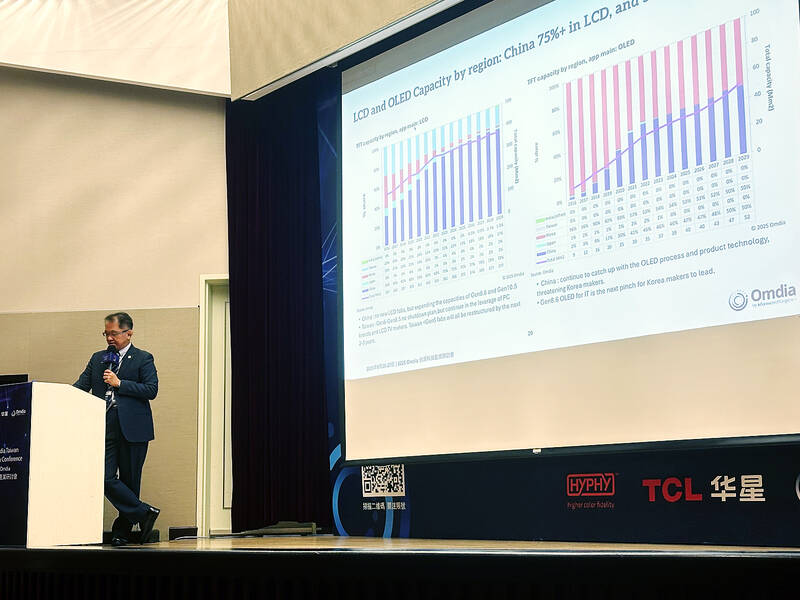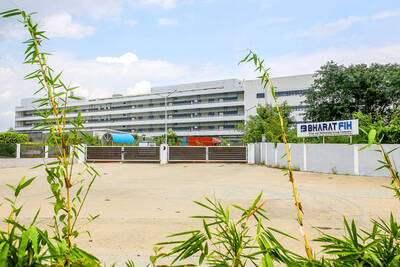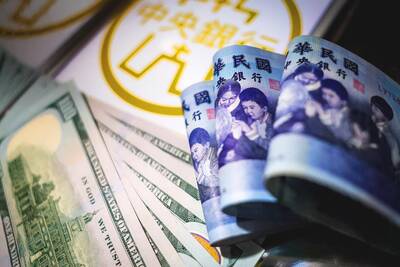Local flat-panel makers AUO Corp (友達) and Innolux Corp (群創) are expected to eke out modest profits in the second half of this year, benefiting from production cuts by Chinese peers to tame overcapacity and bolster panel prices, market researcher Omdia said yesterday.
Chinese flat-panel makers launched a new strategy of managing factory utilization at a profitable range of 75 percent to 80 percent, as decade-long capacity expansions have led to oversupply, it said.
China commands about 76 percent of the global LCD market, greatly surpassing Taiwan’s 19 percent and South Korea’s 4 percent, Omdia data showed.

Photo: Chen Mei-ying, Taipei Times
“Chinese flat-panel makers significantly adjusted their factory utilization when market demand started weakening last month and this month. Such utilization management is very likely to bring the market back to stabilization next month,” Omdia senior director David Hsieh (謝勤益) said at a seminar in Taipei.
The production reduction has yielded positive results and panel prices have stabilized this month, Hsieh said.
That would help supply and demand to reach parity next quarter, he said.
“Keeping factory utilization fluctuating at a narrow range would help safeguard flat-panel makers’ profitability,” Hsieh said.
The global LCD industry follows a human-made production cycle, rather than seasonal cycles or market forces, as it did before, he said, adding that factory utilization for most manufacturers is forecast to hover at about 80 percent this quarter and drop to about 75 percent next quarter.
AUO and Innolux would enjoy stable profits, benefiting from order flux from Chinese TV vendors, he said.
AUO and Innolux swung into profits of NT$5.24 billion and NT$201 million (US$171.5 million and US$6.58 million) in the first half of this year respectively, compared with losses of NT$3.76 billion and NT$2.97 billion in the same period last year.
Omdia trimmed its global flat-panel revenue growth forecast to 3 percent for this year, from the previous 6 percent, on concerns that US tariffs would inflate consumer prices and dent consumer spending, Hsieh said.
The impact was “indirect,” as most display products are exempted from Washington’s tariffs, he said.
Taiwanese panel makers are in the process of transformation by revamping existing factories and expanding into more profitable businesses, he said.
“They have realized 50 percent of their transformation,” Hsieh said. “They have installed all the resources necessary.”
AUO and Innolux are targeting to expand their presence in the car display markets and look at next-generation micro-LED technology through acquisition, Hsieh said.
Innolux last month acquired Japan’s Pioneer Corp to enhance its smart cockpit product lineups, while AUO acquired Germany’s Behr-Hella Thermocontrol GmbH in 2023, he said.
Omdia said it expects Taiwanese firms to continue streamlining manufacturing facilities by retiring less advanced fabs in the next two to three years.

SETBACK: Apple’s India iPhone push has been disrupted after Foxconn recalled hundreds of Chinese engineers, amid Beijing’s attempts to curb tech transfers Apple Inc assembly partner Hon Hai Precision Industry Co (鴻海精密), also known internationally as Foxconn Technology Group (富士康科技集團), has recalled about 300 Chinese engineers from a factory in India, the latest setback for the iPhone maker’s push to rapidly expand in the country. The extraction of Chinese workers from the factory of Yuzhan Technology (India) Private Ltd, a Hon Hai component unit, in southern Tamil Nadu state, is the second such move in a few months. The company has started flying in Taiwanese engineers to replace staff leaving, people familiar with the matter said, asking not to be named, as the

The prices of gasoline and diesel at domestic fuel stations are to rise NT$0.1 and NT$0.4 per liter this week respectively, after international crude oil prices rose last week, CPC Corp, Taiwan (台灣中油) and Formosa Petrochemical Corp (台塑石化) announced yesterday. Effective today, gasoline prices at CPC and Formosa stations are to rise to NT$27.3, NT$28.8 and NT$30.8 per liter for 92, 95 and 98-octane unleaded gasoline respectively, the companies said in separate statements. The price of premium diesel is to rise to NT$26.2 per liter at CPC stations and NT$26 at Formosa pumps, they said. The announcements came after international crude oil prices

DOLLAR SIGNS: The central bank rejected claims that the NT dollar had appreciated 10 percentage points more than the yen or the won against the greenback The New Taiwan dollar yesterday fell for a sixth day to its weakest level in three months, driven by equity-related outflows and reactions to an economics official’s exchange rate remarks. The NT dollar slid NT$0.197, or 0.65 percent, to close at NT$30.505 per US dollar, central bank data showed. The local currency has depreciated 1.97 percent so far this month, ranking as the weakest performer among Asian currencies. Dealers attributed the retreat to foreign investors wiring capital gains and dividends abroad after taking profit in local shares. They also pointed to reports that Washington might consider taking equity stakes in chipmakers, including Taiwan Semiconductor

A German company is putting used electric vehicle batteries to new use by stacking them into fridge-size units that homes and businesses can use to store their excess solar and wind energy. This week, the company Voltfang — which means “catching volts” — opened its first industrial site in Aachen, Germany, near the Belgian and Dutch borders. With about 100 staff, Voltfang says it is the biggest facility of its kind in Europe in the budding sector of refurbishing lithium-ion batteries. Its CEO David Oudsandji hopes it would help Europe’s biggest economy ween itself off fossil fuels and increasingly rely on climate-friendly renewables. While